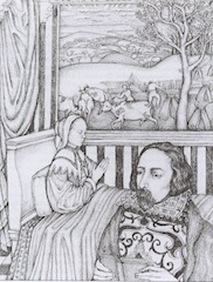|
J. William T. "Bill" Youngs, American Realities, Volume One:
Historical Episodes from First Settlements to the Civil War, Chapter Two |
"The First Thanksgiving," by Jennie A. Brownscombe, courtesy of the Wikipedia Commons
|
|
2. English Background A Puritan Death: John and Thomasine Winthrop |
Summary |
|
Puritanism is generally regarded as one of the most important strands in early American culture, but the Puritans often seem inaccessible to us today because of their complex religious ideas. In this essay their doctrines are presented in concrete historical episodes: a personal search for grace, daily life in an English household, a Puritan encounter with death. In the essay we learn how Puritans oriented their lives to a divine being while undergoing recognizable day-to-day experiences. The story ends with John Winthrop taking his Puritan beliefs across the Atlantic from England to America.
|
Author reads from the Text
In the fall of 1616 the county of Suffolk, England, was a region of great beauty and industry. Travelers walking or riding horses along one of the narrow lanes that led from town to town would have been impressed by the meadows dotted with sheep, the fields of dark soil newly plowed for winter crops, and the fine villages. They would see men and women busy at their tasks: farmers plowing fields behind sturdy horses; dairymaids cleaning stalls and preparing milk, butter, and cheese; housewives making soap or gathering herbs from house gardens; woodsmen cutting timber; and townspeople weaving cloth. In a tavern the visitor might hear men discussing their fields, orchards, and livestock; the land dispute between Smith and Sibley; the marriage of the daughter of a local nobleman; or the religious situation in Germany.
If they had an eye for such things, visitors could also see God in Suffolk County. The Lord was not as discernible as apples or woolens. But He moved over the land, preserving a good man from a bad fall, prospering the fruit crops, punishing a recalcitrant sinner, and engendering a sense of peace and joy in a believer’s heart. It was possible, of course, to live one’s life without being aware of God. Many men and women conducted themselves — their planting and harvesting, cooking and cleaning, begetting and child rearing — as if there were no God. But many others were aware of the presence of the Lord and worshiped him in their homes and churches. Occasionally one of the people of Suffolk left his trim cottage and pleasant fields to dwell in heaven with the Lord.
If they had an eye for such things, visitors could also see God in Suffolk County. The Lord was not as discernible as apples or woolens. But He moved over the land, preserving a good man from a bad fall, prospering the fruit crops, punishing a recalcitrant sinner, and engendering a sense of peace and joy in a believer’s heart. It was possible, of course, to live one’s life without being aware of God. Many men and women conducted themselves — their planting and harvesting, cooking and cleaning, begetting and child rearing — as if there were no God. But many others were aware of the presence of the Lord and worshiped him in their homes and churches. Occasionally one of the people of Suffolk left his trim cottage and pleasant fields to dwell in heaven with the Lord.

